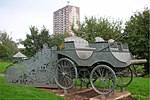Aston railway station

Aston railway station serves the districts of Aston and Nechells in Birmingham, England. The passenger entrance is on Lichfield Road. The station is on the Cross-City Line and the Chase Line. It is one of two local stations for Aston Villa Football Club (the other being Witton) and near to the Aston Expressway and to Gravelly Hill Interchange (Spaghetti Junction). The station is situated adjacent to and above the Lichfield Road (A5127), crossed by a bridge as the railway line, part of the original Grand Junction Railway, opened in 1837, is on an embankment through what was "pastoral parkland" at the time of its construction. The line also crosses the Birmingham and Fazeley Canal, just south of Lichfield Road, on a bridge which is all that remains of a longer viaduct of ten arches, described as "one of the most beautiful structures on the line of the Grand Junction".The section of the viaduct crossing Lichfield Road, immediately south of the station, was replaced by a steel bridge in 1906.
Excerpt from the Wikipedia article Aston railway station (License: CC BY-SA 3.0, Authors, Images).Aston railway station
Lichfield Road, Birmingham
Geographical coordinates (GPS) Address Nearby Places Show on map
Geographical coordinates (GPS)
| Latitude | Longitude |
|---|---|
| N 52.504 ° | E -1.872 ° |
Address
Seventh Day Adventist Church
Lichfield Road
B6 5SX Birmingham
England, United Kingdom
Open on Google Maps






